PC TecAce
Smart TV Platform Study
Smart TVs are integrated with internet connectivity, providing users with a wide range of services. With the rapidly growing technology, the smart TV market is projected to expand even more. Because of the growing demand in the smart TV industry, we researched its market s hare and trend to gain insights and understand better which direction smart TV companies are going. We studied various approaches to designing smart TV UX/UI by some of the largest global companies and their responses to users to their designs to see how different aspects alter the user experience. The purpose of this study was to:
- Understand user priorities
- Compare different approaches to providing content
- Identify partnerships with entertainment companies
- Analyze the complexity and depth of the system structure
1. Methods
Here are several methods to conduct this research.
Affinity map

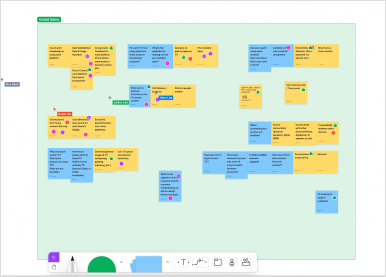
Brainstormed ideas by making an affinity map to gain more insights into research topics from a wide point of view.
Market research
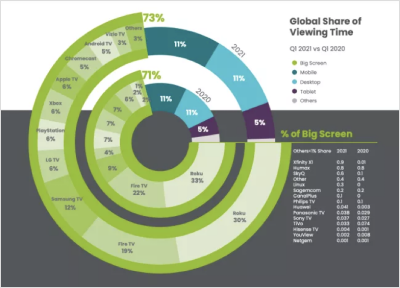
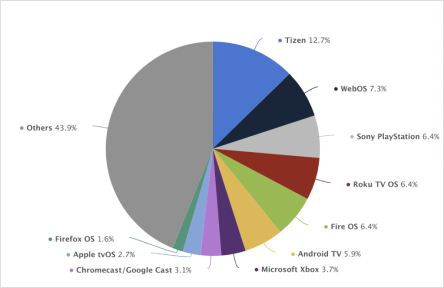
Conducted research on the global smart TV market and trends to decide which smart TVs to look at.
Customer feedback
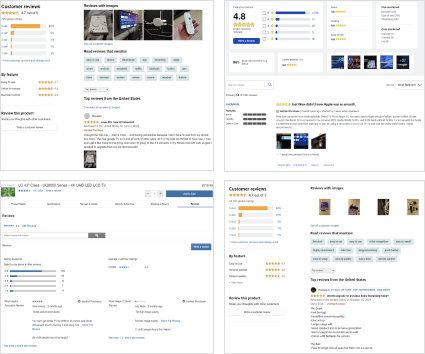

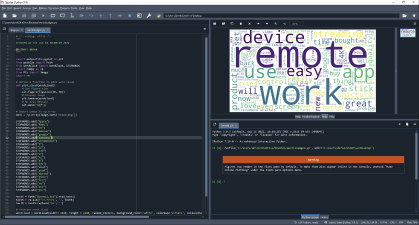
Collected consumers’ and professional tech reviewers’ feedback on the smart TVs to understand what they like and dislike about the TVs.
Comparison
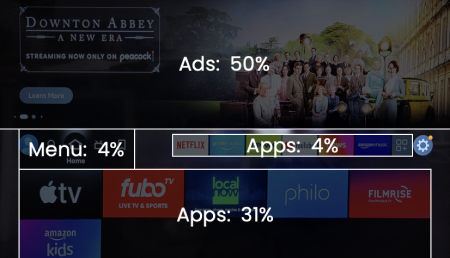
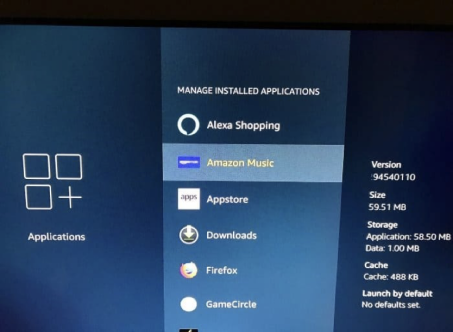


Compared the homescreen, IA structure, and the pre-installed and partner apps to find each brand’s perspective on how they display features and their priorities, and to understand their way of delivering content to consumers.
2. Analysis
The most popular smart TVs
The percentage of viewing time continues to rise, even after mobile and desktop devices became mainstream. The global market of TV-connected devices has been shrinking in favor of smart TVs. Smart TV is a big industry where there can be many business opportunities and we felt the need of learning about the market and its trend.
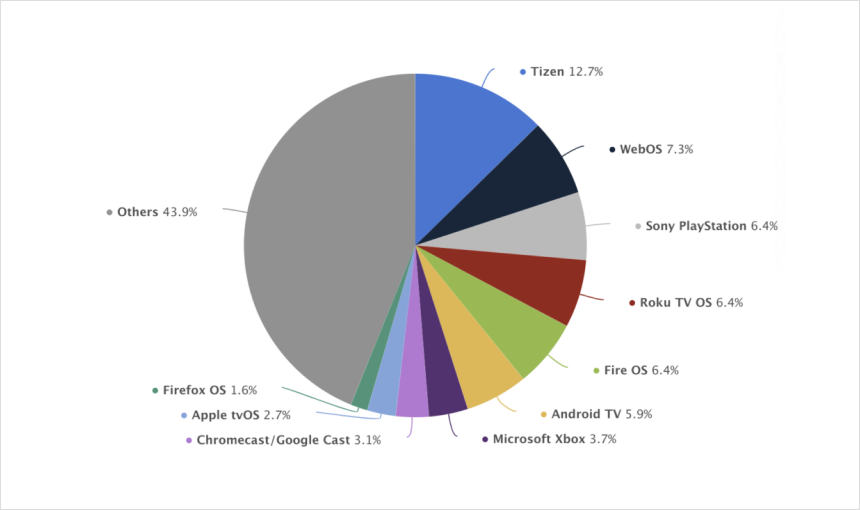
Connected TV Device Global Market Share - Float Left I OTT App Solutions
The most popular TV or TV-connected streaming device operating systems are:
- Tizen (Samsung)
- WebOS (LG)
- RokuTV
- FireOS (Amazon)
- Android TV
- Chromecast
- Apple tvOS
Based on the market research, we selected the top 6 OTT TV devices: Samsung, LG, Amazon, Roku, Google, and Apple.
Homescreen Analysis
To analyze the homescreen, we took a photo of each homescreen of the TV and measured each portion of the section via a Photoshop measurement log. We made the ratio map with the measured data.
Amazon, Google, and Apple focus on providing ads for their content whereas LG and Roku focus on showing their system such as login, search, store, etc. More than 50% of Samsung TV homescreen is occupied by a background showing Samsung TV Plus, their broadcasting channel.
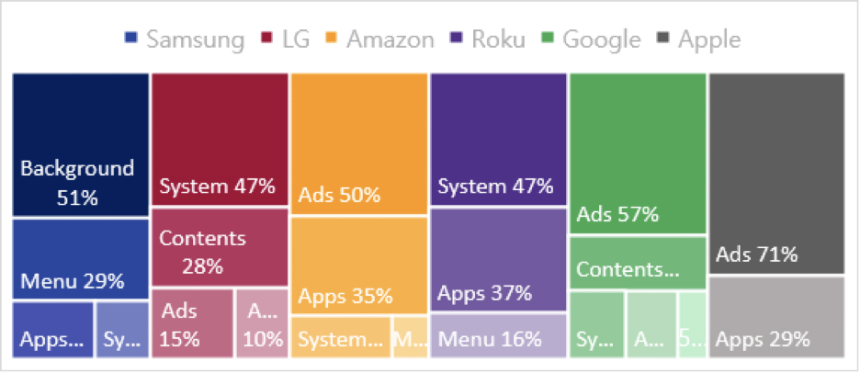
Keywords using word cloud
We extracted the most mentioned words from customer and professional tech reviews to find out the functions they think are the most important. We gathered all the keywords and created a word cloud. We made four categories based on the word cloud: easy adoption, remote control, interface, and content.

Pre-installed apps
We counted, listed, and categorized apps by 1. Pre-installed and shown on their home screens 2. Not pre-installed, but shown on their home screens, 3. Pre-installed, but shown on their home screens, 4. Pre-loaded apps. As the result, Samsung and LG have the most built-in apps, and Apple TV and Chromecast have no distinction between pre-installed and homescreen apps. Also, Apple TV only has first-party applications installed by default. Fire TV, on the other hand, is the only platform to have three kinds of application installs; Home apps are apps that have shortcuts on the default landing page, pre-Installed apps that are already downloaded and installed at the time of set-up, and pre-Loaded apps have their content downloadable but the application itself is not downloaded. It shows a variety of different streaming platforms on its home screen and pre-loaded content, but all pre-installed apps are Amazon-owned. Based on a list of all the apps we have identified, we found that some platforms have a common list of apps pre-installed. Apple TV and Prime Video are the two most common, followed by Netflix, Disney+, YouTube, and Hulu.
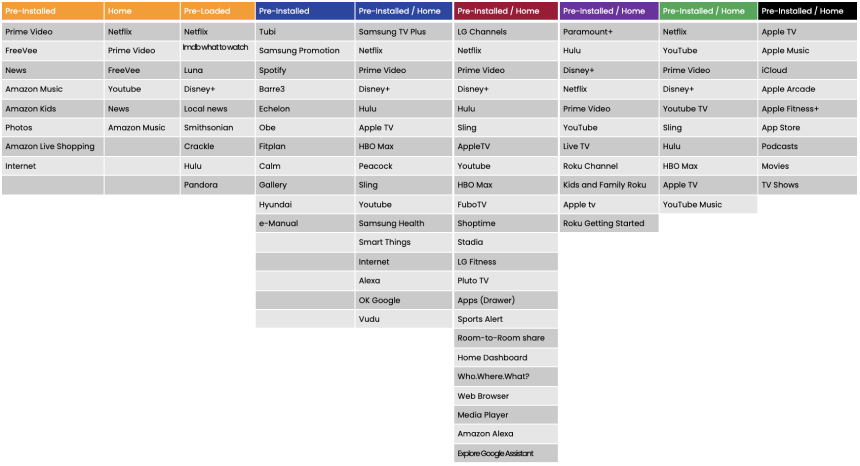
IA flow hierarchy
We investigated an IA flow hierarchy for each platform then simplified it and divide functions by color. We made a score table and make it into a comparison chart to determine which content they are focused on. As a result, Samsung, LG, and apple are generalists that are all-rounders when it comes to providing ads, apps, and other content. Roku and Google are content-centric and tend to focus more on providing robust content. Finally, Amazon is app-centric and focuses on providing as much content as possible

3. Conclusion
We have learned that the smart TV market is rapidly growing with the rise of OTT platforms. Analyzing each brand’s homescreen and IA hierarchy gave us an idea of how they prioritize different types of content and their monetization structure. Reading customer reviews helped us to understand customers’ pain points and their journey to buying smart TV products. We gained insight into the commonalities and differences between these brands and what they’re looking for through this research.
We will continue our research by exploring different topics, such as qualitative research on each brand’s content and user research on the remote control, to fully understand where the smart TV and streaming sticks are going and how they are trying to solve user issues. Despite the growing number of people watching content on their mobile devices, smart TVs and streaming sticks are expected to grow even more in the future market. This research was an opportunity to gain insight into what technical competencies we need to prepare for future projects, and we’re looking forward to further stretching out our technical abilities.